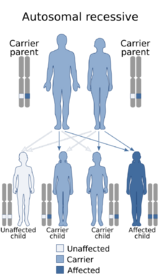Medicine:Eiken syndrome
| Eiken syndrome | |
|---|---|
 | |
| This condition is inherited in an autosomal recessive manner |
Eiken syndrome, also known as "Eiken skeletal dysplasia", is a rare[1] autosomal bone dysplasia with a skeletal phenotype which has been described in a unique consanguineous family, where it segregates as a recessive trait.[2][3] First described in 1985, the syndrome primarily affects the development of bones, leading to short stature, long limbs, and joint dislocations. Eiken syndrome is caused by mutations in the PTH1R gene, located on chromosome 3, and is involved in skeletal development.[4][5]
Signs and symptoms
Delayed ossification characterizes the Eiken syndrome.[5] Individuals with the syndrome may exhibit various orthopedic issues, including abnormal modeling of the bones in the hands and feet, joint hypermobility, abnormal persistence of cartilage in the pelvis, and mild growth retardation.[6]
Diagnosis
Diagnosis often includes clinical evaluation, radiographic imaging, and genetic testing to identify mutations that may be responsible for the syndrome. The disorder typically becomes evident in infancy or early childhood, and its clinical features may vary among affected individuals. The syndrome is very rare, with the seventh patient reported in 2019.[7]
References
- ↑ Hoogendam, Jakomijn; Farih-Sips, Hetty; C. Wynaendts, Liliane; W.G.M Löwik, Clemens; M. Wit, Jan; Karperien, Marcel. "Novel mutations in the PTHR1 causing Blomstrand Osteochondrodysplasia type I and II". Blomstrand Osteochondrodysplasia: 38. https://openaccess.leidenuniv.nl/bitstream/handle/1887/5422/02.pdf?sequence=10.
- ↑ Eiken, M., Prag, J., Petersen, K. and Kaufmann, H. (1984) A new familialskeletal dysplasia with severely retarded ossification and abnormal modeling of bones especially of the epiphyses, the hands, and feet. Eur. J. Pediatr., 141, 231–235.
- ↑ "The Many Faces of PTHR1 Mutations". Growth, Genetics & Hormones 21 (2). June 2005. http://www.gghjournal.com/volume21/2/ab06.cfm.
- ↑ "Eiken syndrome (Concept Id: C1838779) - MedGen - NCBI" (in en). https://www.ncbi.nlm.nih.gov/medgen/325097.
- ↑ 5.0 5.1 Portales-Castillo, Ignacio; Dean, Thomas; Cheloha, Ross W.; Creemer, Brendan A.; Vilardaga, Jean-Pierre; Savransky, Sofya; Khatri, Ashok; Jüppner, Harald et al. (2023-06-02). "Altered Signaling and Desensitization Responses in PTH1R Mutants Associated with Eiken Syndrome". Communications Biology 6 (1). doi:10.1038/s42003-023-04966-0. ISSN 2399-3642. http://dx.doi.org/10.1038/s42003-023-04966-0.
- ↑ Cole, William G. (2013), "Skeletal Dysplasias", Genetics of Bone Biology and Skeletal Disease (Elsevier), http://dx.doi.org/10.1016/b978-0-12-387829-8.00021-4, retrieved 2023-12-13
- ↑ Jacob, Prince; Soni, Jai P.; Mortier, Geert; Girisha, Katta M. (2019-07-11). "The third family with Eiken syndrome". Clinical Genetics 96 (4): 378–379. doi:10.1111/cge.13601. ISSN 0009-9163. http://dx.doi.org/10.1111/cge.13601.
Further reading
- Duchatelet, Sabine; Ostergaard, Elsebet; Cortes, Dina; Lemainque, Arnaud; Julier, Cécile (2005). "Recessive mutations in PTHR1 cause contrasting skeletal dysplasias in Eiken and Blomstrand syndromes". Human Molecular Genetics (Oxford Journals) 14 (1): 1–5. doi:10.1093/hmg/ddi001. PMID 15525660.
- Eiken M, Prag J, Petersen K, Kaufmann H: - A new familial skeletal dysplasia with severely retarded ossification and abnormal modeling of bones especially of the epiphyses, the hands, and feet. Eur J Pediatr 1984, 141:231-235.
External links
| Classification | |
|---|---|
| External resources |
 |

